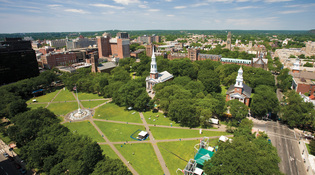 loading
loading
New HavenHeart and soulA hymn to New Haven's Green.  Michael MelfordSite of a witchcraft trial in the past and public concerts in the present, the New Haven Green, New Haven's oldest public space, is the subject of a new documentary. View full image
We all know the oasis called the New Haven Green. Or we think we do. But did you know that the Green served as New Haven’s principal cemetery until the late 1700s, and more than 5,000 unidentified people are still buried there? Or that a witchcraft trial was held on the Green some 40 years before the Salem witch trials? (The convicted woman was spared execution only because of her advanced age.) Or that the Green was once dotted with buildings, including the courthouse where, in 1840, the Amistad captives were declared to be free people, entitled to return to Africa? The Green’s varied history is now the subject of a documentary, The New Haven Green: Heart of a City—written, directed, produced, and edited by filmmaker Karyl Evans, a five-time Emmy winner, and narrated by the actor Paul Giamatti ’89, ’94MFA. “Some people are afraid of the Green” after dark, says Evans, “or they just see it as the place where you wait for the bus. I wanted to bring some understanding about what the Green is all about. To help people see it in a new light.” She interviewed 14 people, including Yale archivist Judith Schiff (author of this magazine’s Old Yale column), architecture professor Alan Plattus ’76, and law professor Drew S. Days III ’66LLB. She also made use of many rarely seen archival photographs, paintings, and hand-colored engravings from both the New Haven Museum and the Yale Archives. “That’s the kind of town it is,” she says. “People actually do that; they keep every scrap of paper.” If there is a single message to the film, Evans says, it is “the important role the Green has had in New Haven and the fact that it is still the center of life in the city after 375 years.” It remains a place so attractive that the American Planning Association has included it on a list of the country’s great public spaces. In the 1940s, there was talk of building a subterranean parking garage beneath the Green. The Committee of the Proprietors of the Common and Undivided Lands in New Haven—the private nonprofit that owns and administers the Green—rejected that plan, as it has rejected most requests to erect statues and monuments. “They wanted an unadorned and park-like setting away from the hustle and bustle,” Evans says. “To me that is important. I feel a sense of calm whenever I’m there.”
The comment period has expired.
|
|